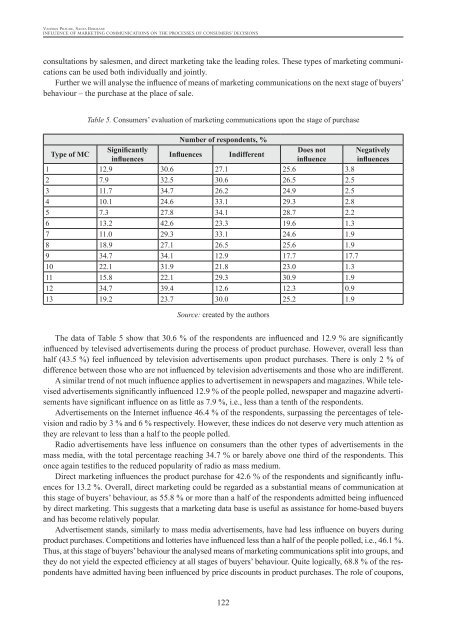regional formation and development studies - KlaipÄdos universitetas
regional formation and development studies - KlaipÄdos universitetas
regional formation and development studies - KlaipÄdos universitetas
You also want an ePaper? Increase the reach of your titles
YUMPU automatically turns print PDFs into web optimized ePapers that Google loves.
Valērijs Praude, Santa Bormane<br />
Influence of Marketing Communications on the Processes of Consumers’ Decisions<br />
consultations by salesmen, <strong>and</strong> direct marketing take the leading roles. These types of marketing communications<br />
can be used both individually <strong>and</strong> jointly.<br />
Further we will analyse the influence of means of marketing communications on the next stage of buyers’<br />
behaviour – the purchase at the place of sale.<br />
Table 5. Consumers’ evaluation of marketing communications upon the stage of purchase<br />
Number of respondents, %<br />
Type of MC<br />
Significantly<br />
Does not Negatively<br />
Influences Indifferent<br />
influences<br />
influence influences<br />
1 12.9 30.6 27.1 25.6 3.8<br />
2 7.9 32.5 30.6 26.5 2.5<br />
3 11.7 34.7 26.2 24.9 2.5<br />
4 10.1 24.6 33.1 29.3 2.8<br />
5 7.3 27.8 34.1 28.7 2.2<br />
6 13.2 42.6 23.3 19.6 1.3<br />
7 11.0 29.3 33.1 24.6 1.9<br />
8 18.9 27.1 26.5 25.6 1.9<br />
9 34.7 34.1 12.9 17.7 17.7<br />
10 22.1 31.9 21.8 23.0 1.3<br />
11 15.8 22.1 29.3 30.9 1.9<br />
12 34.7 39.4 12.6 12.3 0.9<br />
13 19.2 23.7 30.0 25.2 1.9<br />
Source: created by the authors<br />
The data of Table 5 show that 30.6 % of the respondents are influenced <strong>and</strong> 12.9 % are significantly<br />
influenced by televised advertisements during the process of product purchase. However, overall less than<br />
half (43.5 %) feel influenced by television advertisements upon product purchases. There is only 2 % of<br />
difference between those who are not influenced by television advertisements <strong>and</strong> those who are indifferent.<br />
A similar trend of not much influence applies to advertisement in newspapers <strong>and</strong> magazines. While televised<br />
advertisements significantly influenced 12.9 % of the people polled, newspaper <strong>and</strong> magazine advertisements<br />
have significant influence on as little as 7.9 %, i.e., less than a tenth of the respondents.<br />
Advertisements on the Internet influence 46.4 % of the respondents, surpassing the percentages of television<br />
<strong>and</strong> radio by 3 % <strong>and</strong> 6 % respectively. However, these indices do not deserve very much attention as<br />
they are relevant to less than a half to the people polled.<br />
Radio advertisements have less influence on consumers than the other types of advertisements in the<br />
mass media, with the total percentage reaching 34.7 % or barely above one third of the respondents. This<br />
once again testifies to the reduced popularity of radio as mass medium.<br />
Direct marketing influences the product purchase for 42.6 % of the respondents <strong>and</strong> significantly influences<br />
for 13.2 %. Overall, direct marketing could be regarded as a substantial means of communication at<br />
this stage of buyers’ behaviour, as 55.8 % or more than a half of the respondents admitted being influenced<br />
by direct marketing. This suggests that a marketing data base is useful as assistance for home-based buyers<br />
<strong>and</strong> has become relatively popular.<br />
Advertisement st<strong>and</strong>s, similarly to mass media advertisements, have had less influence on buyers during<br />
product purchases. Competitions <strong>and</strong> lotteries have influenced less than a half of the people polled, i.e., 46.1 %.<br />
Thus, at this stage of buyers’ behaviour the analysed means of marketing communications split into groups, <strong>and</strong><br />
they do not yield the expected efficiency at all stages of buyers’ behaviour. Quite logically, 68.8 % of the respondents<br />
have admitted having been influenced by price discounts in product purchases. The role of coupons,<br />
122

















